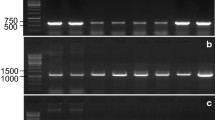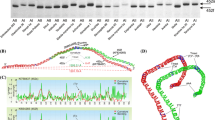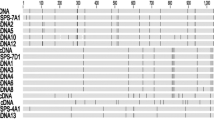Abstract
Wheat polyphenol oxidase (PPO) is the major cause of browning reactions that discolor Asian noodles and other wheat products. It has been hypothesized that genes encoding wheat PPOs may have evolved by gene duplication into a multigene family. Here we characterized PPO genomic sequences from diploid (Triticum monococcum, T. urartu, Aegilops tauschii, and Ae. speltoides), tetraploid (T. turgidum, subspecies dicoccoides and durum) and hexaploid (T. aestivum cultivars Klasic and ID377s) wheat species to gain a better understanding of the structure and organization of PPO genes. DNA fragments were amplified from a highly polymorphic and phylogenetic informative region of the gene. As a result, we obtained highly discriminative sequences. Three distinct PPOs, obtained from the A genome of T. monococcum, provided evidence for gene duplication events (paralogous loci). Furthermore, the number of sequences obtained for bread and durum wheat was higher than the expected number of orthologous loci. Sequence comparison revealed nucleotide and structural diversity, and detected five sequence intron types, all with a common insertion position. This was hypothesized to be homologous to that of intron 2 of previously reported wheat PPOs. A MITE of the Stowaway family accounted for the major difference between the five intervening sequences, and was unique to T. aestivum cv. Klasic. Nucleotide and structural diversity, together with well-resolved phylogenetic trees, provided molecular evidence to support the hypothesis of a PPO multigene family structure and organization.





Similar content being viewed by others
References
Anderson JA, Morris CF (2003) Purification and analysis of wheat grain polyphenol oxidase (PPO) protein. Cereal Chem 80:135–143
Baik BK, Czuchajowska Z, Pomeranz Y (1994) Comparison of polyphenol oxidase activities in wheats and flours from Australian and US cultivars. J Cereal Sci 19:291–296
Brown JW, Smith P, Simpson CG (1996) Arabidopsis consensus intron sequences. Plant Mol Biol 32:531–535
Bureau TE, Wessler SR (1994a) Stowaway: a new family of inverted repeat elements associated with the genes of both monocotyledonous and dicotyledonous plants. Plant Cell 6:907–916
Bureau TE, Wessler SR (1994b) Mobile inverted-repeat elements of the tourist family are associated with the genes of many cereal grasses. Proc Natl Acad Sci USA 91:1411–1415
Colson P, Tamalet C, Raoult D (2006) SVARAP and aSVARAP: simple tools for quantitative analysis of nucleotide and amino acid variability and primer selection for clinical microbiology. BMC Microbiol 6:21
Demeke T, Morris CF (2002) Molecular characterization of wheat polyphenol oxidase (PPO). Theor Appl Genet 104:813–818
Demeke T, Morris CF, Campbell KG, King GE, Anderson JV, Chang HG (2001) Wheat polyphenol oxidase: distribution and genetic mapping in three inbred line populations. Crop Sci 416:1750–1757
Feschotte C, Jiang N, Wessler SR (2002) Plant transposable elements: where genetics meets genomics. Nat Rev Genet 3:329–341
Frugoli JA, McPeek MA, Thomas TL, McClung CR (1998) Intron loss and gain during evolution of the catalase gene family in Angiosperms. Genetics 149:355–365
Gooding PS, Bird C, Robinson SP (2001) Molecular cloning and characterization of banana fruit polyphenol oxidase. Planta 213:748–757
Jimenez M, Dubcovsky J (1999) Chromosome location of genes affecting polyphenol oxidase activity in seeds of common and durum wheat. Plant Breed 118:395–398
Jukanti AK, Bruckner PL, Fischer AM (2004) Evaluation of wheat polyphenol oxidase genes. Cereal Chem 81:481–485
Jukanti AK, Bruckner PL, Fischer AM (2006) Molecular and biochemical characterization of polyphenol oxidases in developing kernels and senescing leaves of wheat (Triticum aestivum). Funct Plant Biol 33:685–696
Khamis A, Colson P, Raoult D, Scola BL (2003) Usefulness of rpoB gene sequencing for identification of Afipia and Bosea species, including a strategy for choosing discriminative partial sequences. Appl Environ Microbiol 69:6740–6749
Kumar S, Tamura K, Nei M (2004) MEGA3: integrated software for molecular evolutionary genetics analysis and sequence alignment. Brief Bioinform 5:150–163
Mayer AM, Harel E (1979) Polyphenol oxidases in plants. Phytochemistry 18:193–215
Morris CF, Jeffers HC, Engle DA (2000) Effect of processing, formula and measurement variables on alkaline noodle color—toward an optimized laboratory system. Cereal Chem 77:77–85
Morimoto R, Kosugi T, Nakamura C, Takumi S (2005) Intragenic diversity and functional conservation of the three homoeologous loci of the KN1-type homeobox gene Wknox1 in common wheat. Plant Mol Biol 57:907–924
Murray MG, Thompson WF (1980) Rapid isolation of high molecular plant DNA. Nucleic Acids Res 8:4321–4325
Newman SM, Eannetta NT, Yu H, Prince JP, de Vicente MC, Tanksley SD, Steffens JC (1993) Organization of the tomato polyphenol oxidase gene family. Plant Mo1 Biol 21:1035–1051
Petersen G, Seberg O (2000) Phylogenetic evidence for excision of stowaway miniature inverted-repeat transposable elements in triticeae (Poaceae). Mol Biol Evol 17:1589–1596
Sherman TD, Gardeur TL, Lax AR (1995) Implications of the phyogenetic distribution of polyphenol oxidase in plants. In: Lee CY, Whitaker JR (eds) Enzymatic browning and its prevention. American Chemical Society, Washington, DC, pp 103–119
Simeone R, Pasqualone A, Clodoveo ML, Blanco A (2002) Genetic mapping of polyphenol oxidase in tetraploid wheat. Cell Mol Biol Lett 7:763–769
Sparks ME, Brendel V (2005) Incorporation of splice site probability models for non-canonical introns improves gene structure prediction in plants. Bioinformatics 21:iii20–iii30
Sullivan ML, Hatfield RD, Thoma SL, Samac DA (2004) Cloning and characterization of red clover polyphenol oxidase cDNAs and expression of active protein in Escherichia coli and transgenic alfalfa. Plant Physiol 136:3234–3244
Sun DJ, He ZH, Xia XC, Zhang LP, Morris CF, Appels R, Ma WJ, Wang H (2005) A novel STS marker for polyphenol oxidase activity in bread wheat. Mol Breed 16:209–218
Swofford DL (2002) PAUP: phylogenetic analysis using parsimony, version 4.0b 10. Sinauer Associates, Sunderland, MA
Thompson JD, Gibson TJ, Plewniak F, Jeanmougin F, Higgins DG (1997) The CLUSTAL_X Windows interface: flexible strategies for multiple sequence alignment aided by quality analysis tools. Nucleic Acids Res 25:4876–4882
Thygesen PW, Dry IB, Robinson SP (1995) Polyphenol oxidase in potato. Plant Physiol 109:525–531
Watanabe N, Takeuchi A, Nakayama A (2004) Inheritance and chromosomal location of the homoeologous genes affecting phenol colour reaction of kernels in durum wheat. Euphytica 139:87–93
Wicker T, Matthews DE, Keller B (2002) TREP: a database for triticeae repetitive elements. Trends Plant Sci 7:561–562
Zhou Y, O’Hare TJ, Jobin-Décor m, Underhill SJR, Wills RBH, Graham MW (2003) Transcriptional regulation of a pineapple polyphenol oxidase gene and its relationship to blackheart. Plant Biotechnol J 1:463–478
Zhu W, Schlueter SD, Brendel V (2003) Refined annotation of the Arabidopsis genome by complete expressed sequence tag mapping. Plant Physiol 132:469–484
Zuker M (2003) Mfold web server for nucleic acid folding and hybridization prediction. Nucleic Acids Res 31:3406–3415
Author information
Authors and Affiliations
Corresponding author
Additional information
Communicated by A. Kilian.
Mention of trademark or proprietary products does not constitute a guarantee or warranty of a product by the US Department of Agriculture and does not imply its approval to the exclusion of other products that may also be suitable. This article is in the public domain and not copyrightable.
An erratum to this article is available at http://dx.doi.org/10.1007/s00122-007-0531-3.
Rights and permissions
About this article
Cite this article
Massa, A.N., Beecher, B. & Morris, C.F. Polyphenol oxidase (PPO) in wheat and wild relatives: molecular evidence for a multigene family. Theor Appl Genet 114, 1239–1247 (2007). https://doi.org/10.1007/s00122-007-0514-4
Received:
Accepted:
Published:
Issue Date:
DOI: https://doi.org/10.1007/s00122-007-0514-4




